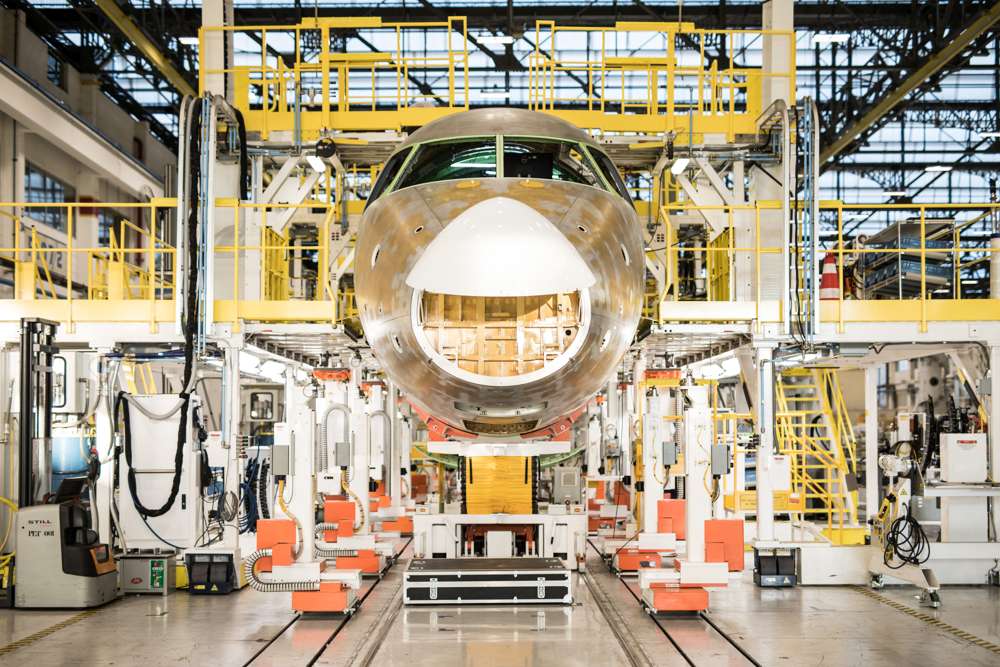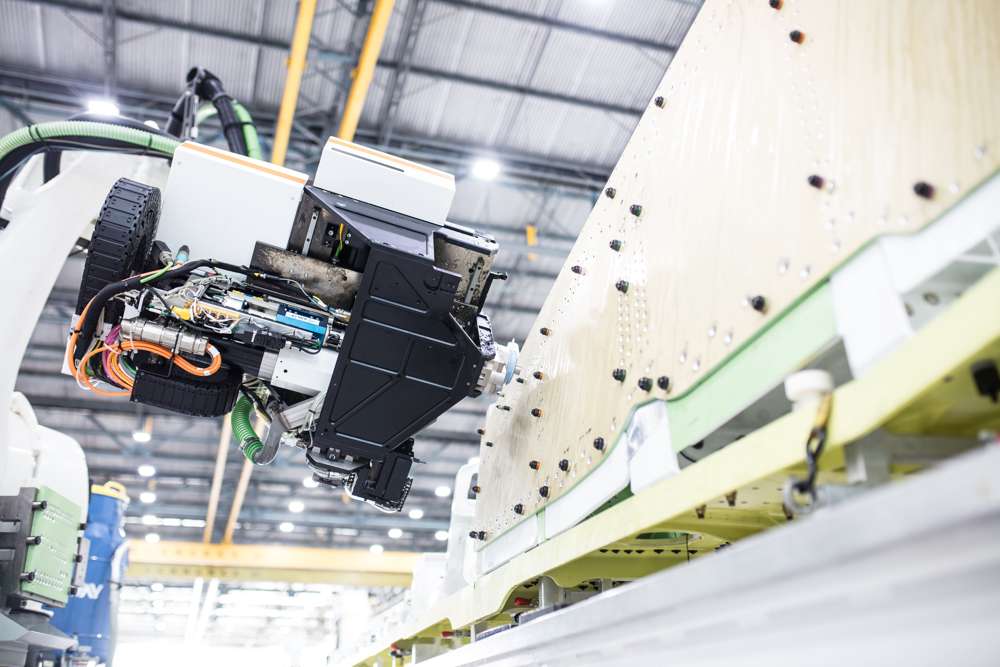Best of both worlds

Brazilian OEM, Embraer is controlling costs by building its new E190-E2 passenger jets on its E1 assembly line. James Careless reports.
Launching a new commercial airliner can be an extremely expensive business. This is why OEMs try hard to reduce the costs associated with new product launches; without compromising aircraft quality or affecting the productivity of their overall manufacturing operations.
Brazilian aircraft manufacturer, Embraer is facing this challenge as it brings the new E190-E2 airliner to market. Built upon the original generation of twin-engine E-Jets, the E190-E2 features Pratt & Whitney PW1000G engines, a new wing and other advances that collectively make this aircraft 17.3% more fuel-efficient than the E190-E1. This improved fuel efficiency, plus the adoption of more aerodynamic high aspect ratio wings, increases the E190-E2's range by 800km (5,334km compared to the E190-E1's 4,320km).
The longer range E190-E2 positions Embraer to compete more effectively against the Airbus A220 (formerly the Bombardier C Series), and Boeing’s 737 MAX.
To realise this competitive advantage while keeping manufacturing costs under control, Embraer has adopted a ‘hybrid’ production approach where E190-E2s are being built on the same assembly line as E190-E1s. In plain English, one assembly line is producing E1s and E2s; in whatever mix and sequence makes the most sense, based on contracts and delivery demands.
“The hybrid line concept allows Embraer to deliver a floating mix of E1/E2 models in all variants according to market demands,” says Embraer’s strategy manager, Daniel Galhardo Gomes. “It also minimises the required infrastructure and new industrial footprint during the E1/E2 production transition phase.”
Eventually, as the E1 is phased out, the line will increase its output of E2 models. This will be done without any significant downtime, manufacturing obsolescence, or need to radically overhaul the line to make this change. At the same time, assembling building both aircraft families in the same place allows Embraer to get the E2 into production sooner, compared to building a new manufacturing complex and associated tooling first.
All together now
Embraer’s hybrid E1/E2 assembly line is based at the company’s Faria Lima factory facility. It is located about 90km northeast of São Paulo, and is Embraer’s oldest production centre.

The assembly line travels through four buildings at Faria Lima. The work begins in Building F-60, which has two assembly bays. One bay is used for connecting and completing the front and centre parts of the aircraft fuselage. The rear is then added and the fuselage completed in the second bay. The completed fuselage then goes into the paint bay in F-210, moves to F-107 to have its wings attached, and then into F-220 for final assembly.
Initially, this line only assembled aircraft of the E1 family; specifically, the E170 (66-78 passengers), the E175 (76-88), the E190 (88-114) and the E195 (100-124). Meanwhile, the flight test versions of the E190-E2 (97-114) were built in a separate hangar.
Now that production has commenced, the E190-E2 is being manufactured using the original E1 assembly line. This will also be the case for other E2 variants, such as the E175-E2 (80-90) and the E195-E2 (120-146) as they enter production.
Functionally, “the hybrid line starts in the fuselage junction and all following assembly stations are shared until the delivery of the aircraft,” says Gomes. “Basically, all major assembly processes and tooling are hybrid including fuselage and wing junctions. Some specific processes like hydraulic flushing require separated equipment but are still performed by the same operators.”
Some of the E1/E2's major structural assemblies are also being built on the shared hybrid line. These include the forward fuselage junctions, and the fuselage/wing panel riveting stations.
Making hybrid production work
The challenges of hybrid production are daunting. Embraer is building two generations of aircraft on the same line. This requires workers to go back and forth in the skills they employ and the tooling they use on the job, as they alternate between one generation and the other.
To ease this process, Embraer has been teaching its technicians to build E1s using tooling and equipment that can also be used to build E2s. This allows staff to be “trained in new resources while building a well-known product,” says Gomes.

Embraer also introduced its key shopfloor operators to the E2 assembly process as the prototype E2s were being built for flight testing. This early introduction meant that these operators could aid their fellow technicians when the E2s were added to the E1 line.
From the beginning, Embraer’s designers understood that it would be easier for E1-trained technicians to build E2s if the two aircraft families and their assembly procedures were as similar as possible.
“This requirement was perceived at the pre-design phase,” states Gomes; a perception that influenced how the E2 was subsequently designed and readied for production going forward.
Still, two generations of aircraft are two generations: Even with common tooling and manufacturing processes, the E1s and E2s have significant differences. This makes switching from an E175-E1 to a E190-E2 potentially confusing for Embraer workers – and confusion can lead to mistakes.
To minimise these “human cognitive loads”, as Gomes calls them, the company worked hard to develop ‘poka-yoke’ design solutions for E1/E2 products, tooling and equipment. Poka-yoke is the Japanese term for ‘mistake-proofing’; literally analysing all aspects of a production process to identify and eliminate as many chances for human error as possible.
“Assembly and test automation are other ways to ensure the operators are performing the right tasks for every mode,” says Gomes. “As for logistics: Embraer already had a fairly flexible supply and delivery system, but investments like a state-of-the-art manufacturing execution system were also required to implement the hybrid line.”
Benefits and lessons learned
Moving to an E1/E2 assembly line is paying off as planned for Embraer. “The goal of minimising investments and an additional industrial footprint has been achieved as well as the flexibility of running different model mixes in the line to accommodate market demands,” Gomes explains.
This flexibility is welcome news given that Republic Airways signed a purchase order for 100 E175-E1s in 2018 – with the right to convert them to E175-E2s – plus an option for 100 more. In a non-hybrid manufacturing environment, Republic’s conversion prerogative could be a source of chaos.
“As a positive collateral effect, the level of production similarities and test automation led also to simplified maintenance tasks and a smoother E1 to E2 transition for clients,” notes Gomes.

This said, moving to a hybrid line has taught Embraer two valuable manufacturing lessons. Firstly: “A hybrid production system, if required, needs to be considered a ‘killer’ driver for design and development programmes,” states Gomes.
In other words, hybrid manufacturing cannot be tacked on as a money-saving afterthought. The aircraft being made using this system must be designed and optimised for hybrid production from the outset; as must the tooling, worker training, and factory areas where the aircraft are to be built.
“It's not possible to just adapt a production system if the product is not oriented to that strategy,” said Gomes.
Secondly: Adopting the hybrid approach can do much more for a manufacturer than just reduce the cost of bringing a new aircraft to market.
“The benefits go way beyond the shop floor; providing flexibility on sales and resulting in direct maintenance, service and benefits to clients,” he concludes.
The bottom line: The E1/E2 hybrid production line allows Embraer to ease the E2 into production today, and phase out the E1 out of production when the E2 eventually replaces it in the global marketplace.












